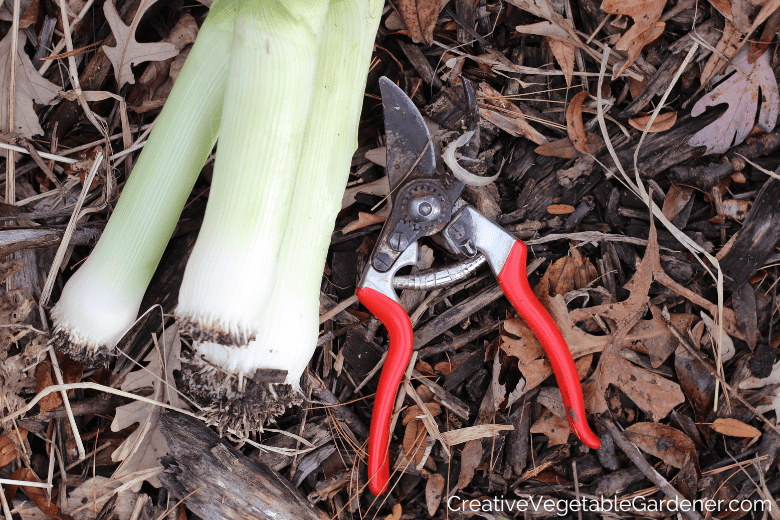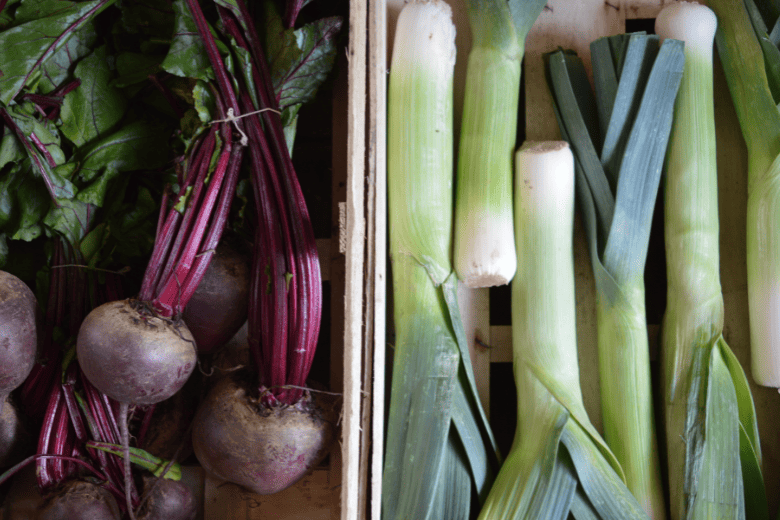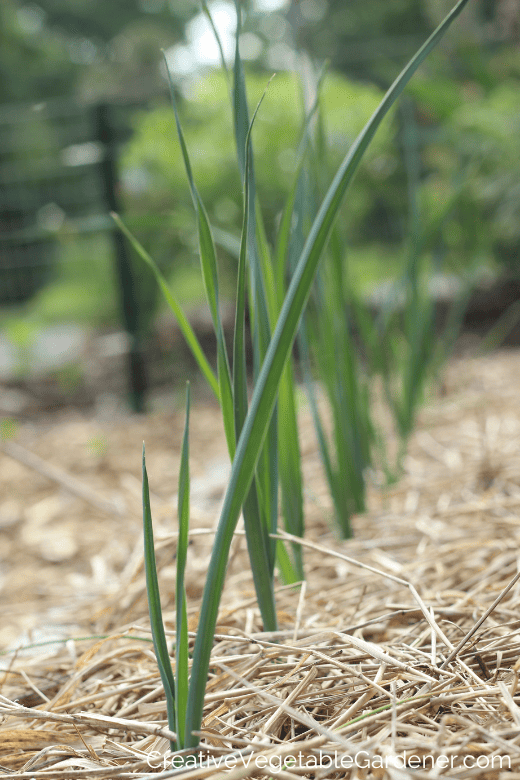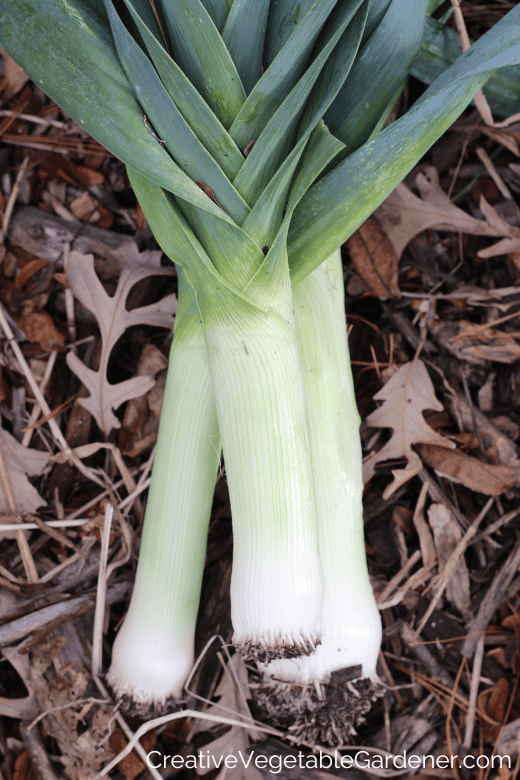I’m not shy about how much I love growing alliums in my garden. Every fall I plant 220 garlic and each spring 500 onions. I harvest and cure them in my garage in mid July and in fall I transfer them to my basement to use throughout the winter so I never have to buy them at the grocery store.
Cooking at our house often starts with sautéing onions and garlic in a pan with a little oil. And we have a joke that when a recipe calls for one clove of garlic it actually means one bulb.
All that to say – I love alliums! But, for some reason, although leeks are also a member of the allium family, they feel like a different category.
I think that’s partly because although I plant them in April at the same time as my onions, when I’m harvesting leeks it’s fall, not July when I harvest the other hundreds of onions and garlic I grow.
But, this is also a bonus if you think about it. Growing leeks is a way to spread out your allium harvest. I actually love growing a fall garden, and leeks can sit in the garden as the weather turns cold and heads into winter.
If you’re not a big fan of garlic and onions (she gasps!), leeks, with their mild and delicate flavor, could be a better option for you.
As with all vegetables in your garden, it’s essential to know when and how you should be harvesting leeks, as well as how to store or freeze them for future use. Let’s dive in!
When to Harvest Leeks
In most gardening zones with four seasons, leeks are planted in the spring and harvested in the fall. In my Wisconsin zone 5 garden, I plant my leeks at the same time as my onions, mid-April. But, unlike onions, the leeks will stay in the garden for much longer. Most varieties take about 110 days from planting a seedling to the harvest date.
Leeks are typically ready for harvest when they have reached roughly 1 to 1.5 inches in diameter and 6 to 10 inches in length. However, you can leave them in the ground longer if you prefer larger leeks.
Because they are so cold hardy, I suggest leaving them in your garden for as long as possible in the late fall and harvesting leeks as you need them. If you’ve grown a lot, this will free up space in your fridge. Some leek varieties are hardy down to 15 degrees F.
If you live in a warmer gardening zone, you may be able to plant leeks in the fall for a spring harvest. Check your local university extension website for suggested planting dates if you live in zone 7 or higher.

How to Harvest Leeks
Like the other alliums, harvesting leeks is a pretty straightforward process, but should be done with care to avoid damaging the plant. Most of the leek sits on top of the soil, but it does have quite a thick network of roots under the surface.
Before attempting to pull out a leek, gently loosen the soil around it using a garden fork or trowel. This makes it easier to extract the leek without breaking the stalk.
Once you’ve loosened the soil, reach down and grab the leek as close to its base as possible. Slowly pull the leek upward while gently twisting it. This motion helps release it from the soil without causing damage to the stalk.
I like to leave as much soil as possible in my garden beds, so immediately after harvesting, I use pruners to trim the roots at the base of the leek. I let the roots fall back onto the soil to break down naturally.
I also trim the leaves back a bit, so they look more like the leeks you’d buy at the grocery store. You can put the trimmings in your compost bin or just leave them on the garden bed to compost in place. If you like making your own soup stock, you can wash and save them for later. More on that below.)
Because I have a huge garden and harvest tons of vegetables, I don’t always wash my vegetables before putting them into the fridge. Sometimes things just get thrown in bags dirty and I deal with them later.
But, ideally, try to spray the leeks off with the hose, especially the part that came out of the ground, before bringing them inside to cut down on the amount of soil that’s makes it into your kitchen.
Because of the way leeks are designed, they tend to trap a lot of soil in the areas where the leaves transition to the stem. I tend not to address this until I’m about the use a leek for cooking because it’s an area that hard to get to without cutting the leek.

Photo by Lucy May on Unsplash
How to Store Leeks
The biggest mistake I see most people making when they store vegetables is not placing them in plastic bags. The refrigerator will suck the moisture from your vegetables if you simply place them in the fridge bare naked. I find this is true even in fridges that have vegetable storage drawers.
If you want your vegetables to remain crisp and last longer, store them in plastic bags. At our house, we use the same plastic bags over and over again and then recycle them when they’re too far gone to use anymore.
It’s not a great idea to place wet vegetables into plastic bags, since there’s not much air circulation to help them dry, so after harvesting leeks let them air dry for awhile or gently pat them with a clean towel before storing them in the fridge.
Properly stored leeks can stay fresh for up to 2-3 months. If the outer leaves get a little soggy or start turning yellow, simply peel them off and discard them in the compost. The inner part of the leek should be just fine for cooking.

Photo by Hanna Balan on Unsplash
Freezing Leeks
Leeks are one of the vegetables I talk about in my book, Super Easy Food Preserving, that store for a fairly long time in the fridge. But, they do start to go bad after 2-3 months. If you have an abundance after harvesting leeks or you find that the ones you have stored in the fridge are starting to go bad, freezing is an excellent preservation method.
Although some articles online instruct you to blanch the leeks before freezing, I don’t find that it’s necessary.
Here’s how to freeze leeks:
- Clean the leeks thoroughly and slice them into rounds or chop them to your desired size. The white and light green parts are the most flavorful.
- If they’re wet, give them a spin in the salad spinner to remove excess moisture.
- Optional: Mix them with a little olive oil in a bowl.
- Pack into freezer bags or containers. I use wide mouth pint canning jars for freezing leeks.
- Remember to label the containers or bags with the date, so you can keep track of their freshness. Frozen vegetables should be eaten with one year.
Freezing Leek Scraps for Soup Stock
I love making my own soup stock for winter soups and stews. It has way more flavor, and way fewer additives, than what you buy at the grocery store.
I keep a gallon freezer bag at the front of my freezer for storing food scraps for soup stock. I most commonly throw in onion, garlic, leeks, carrot, celery, parsley, thyme, and rosemary into my bag. I don’t recommend saving any brassicas (broccoli, kale, cabbage, etc) berceuse they can turn soup stock bitter. You can also include tomatoes, peppers, basil and other herbs.
If you eat meat, you can include chicken, beef or other bones (except fish) as well.
Every so often when I’m in need of soup stock I empty my scrap bag into my Instant Pot, add salt, pepper and herbs if there aren’t any already in there, and cook it for 45 minutes. After it cools down, I strain out the solids and pour the stock into containers for freezing. I don’t use glass anymore because I’ve had jars crack and break on me, even when they’re labeled “freezer safe”. I prefer old yogurt containers or other plastic storage containers.
Favorite Recipes for Leeks
Potato Leek Soup: make a big batch with your freshly harvested leeks and freeze it for a cold February evening.
Leek Fritters: We make various types of fritters throughout the year. This is a good fall one!
Best Stuffing: We always make this recipe for Thanksgiving with our homegrown leeks
Roasted Cauliflower and Leek Soup

How to Grow Leeks
Leeks are best grown from seedlings in your garden. I don’t recommend direct seeding. If you start your own seeds at home in winter, you can purchase a packet of leek seeds and start them around the same time as your onions. Early mid-February is when I start mine in Wisconsin.
Plant your leeks about four weeks before your average last frost. I plant mine in mid-April in zone 5, the same time I plant my onions. Leeks thrive in well-drained soil and prefer full sun, but can tolerate partial shade.
I use the same spacing as onions – 6 inches apart on all sides. That means I can fit up to 6 rows lengthwise in my garden bed, depending on how wide it is (mine vary throughout my garden).
Keep the soil consistently moist but not waterlogged. Pay extra attention to watering newly planted seedlings. I like to water every day for the first week or two and then I switch to making sure all of my vegetable plants get 1 inch of water per week, including rainfall. More tips on watering your vegetable garden the right way.
I highly recommend mulching your leeks after a few weeks of growth (they’re easier to work around when they get a little bigger). This will help retain soi moisture and suppress weeds over the many months they’ll be hanging out in your garden. Read more about why I think vegetable garden mulch is the ultimate garden tool!
You many have heard about a process called “blanching”. As leeks grow, you can mound soil around the base to encourage longer white stalks. I’m kind of a lazy gardener, so I never do this.
As previously discussed, harvest your leeks when they reach the desired size and have a white, firm stalk.
I don’t grow as many leeks as I do onions and garlic in my garden, but I do like to work 10-15 into my planting plan each year. I love that they are harvested in the fall, just when my garden is starting to feel a little empty. They’re also one of those quintessentially winter vegetables, along with Brussels sprouts and winter squash.
Now that you’ve learned everything you need to know about harvesting leeks, I highly encourage you to try growing them in your own garden next season.
SHARE IT ON PINTEREST

